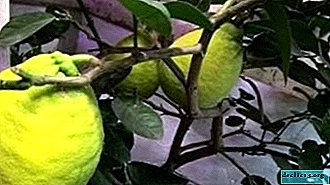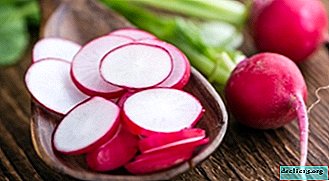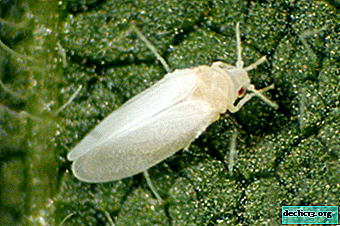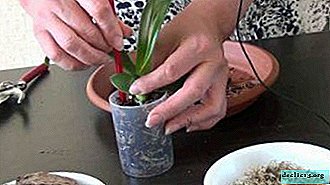Features of the citrus hybrid - Panderos lemon. Care and Reproduction Tips

Panderosa lemon is one of the most unpretentious varieties of citrus fruits, characterized by its ability to adapt to any external conditions. The fruits of this variety are larger in size compared to others.
In this article you can get acquainted with the characteristics and features of this interesting lemon variety, the features of caring for it and the history of its occurrence.
The history of the variety and its name
Lemon Panderosa (Ponderosa) - a hybrid obtained by crossing grapefruit, citron and lemon. The name of this lemon comes from the Latin "ponderous", "heavy". There is another version of the origin of the name of the hybrid - from the Italian word "ponderosa", which can be translated as "strong, powerful."
Panderosa fruits differ from other lemon varieties in their large sizes.There is also a different opinion about the history of Panderose. According to one version, this is a variety of natural origin, obtained by chance in the United States in 1887. The name was given to the new variety later, and it only appeared on the market in 1900. According to another version, the hybrid was obtained at the end of the 19th century by the American gardener Bowman.
India is considered the birthplace of lemon. In the wild, it does not grow, since it is a hybrid. They grow it mainly in warm countries:
- Italy;
- Spain;
- Greece;
- Turkey;
- Cyprus;
- Lebanon.
In Russia, Panderosa is grown in the subtropics of the Caucasus.
Description with photo
Panderosa lemon is a small decorative tree whose height usually does not exceed a meter. Belongs to medium-sized plants. The bark is gray, tuberous; in adult plants, thorns can occur on the trunk and branches.
The leaves have an oval shape, saturated dark green color, they are hard and smooth to the touch. Every three years, the tree changes foliage. Cron is very easy to form, it branches well.
Below are the photos:





Bloom
This The variety is distinguished by its rapid flowering from other lemons.. Panderosa can bloom two or three times in one year, and the flowers “stick around” the plant so much that they can grow even on the trunk, and even the tree itself can not be seen, it turns into a large fragrant ball of beautiful white-cream flowers collected in the brush.
Such beauty is very pleasing to the eye, but there will be few fruits at the same time, so it is important to cut flowers in a timely manner, without waiting for them to blossom, otherwise abundant flowering will impede the development of leaves and branches.
Fruit
The first crop from a tree can be harvested in the second year after planting. It is for the size of the fruits of Panderosa that it got its name - with proper care, you can get lemons weighing a kilogram or more.Lemons can be round or pear-shaped, bumpy, peel yellow, has a thickness of about 1 cm. The flesh is acidic, the taste is not typical for a lemon, it also contains notes of citron and grapefruit. There are a lot of seeds in the pulp.
Distinctive features
As mentioned above, the main characteristic feature of this hybrid is its fruits, which differ from the fruits of lemons of other varieties not only in their record sizes, but also in taste. Other characteristics of the variety are compactness and frequent profuse flowering.
Hybrid care rules at home
Temperature
Panderosa is considered one of the most thermophilic varieties of lemons., tolerates heat and arid weather well. But you must remember that the variety also likes fresh air, so the best place to grow it in the house will be a balcony. You can simply put a panderoza pot next to the window.
Watering
 This lemon does not require frequent watering. Too much lemon tree is not recommended, it will be enough to maintain the soil in a slightly moistened state. If you see that the outer layer of soil is dry, water the tree. It is better to water no more than once a week.
This lemon does not require frequent watering. Too much lemon tree is not recommended, it will be enough to maintain the soil in a slightly moistened state. If you see that the outer layer of soil is dry, water the tree. It is better to water no more than once a week.
You also need to monitor air humidity and, if necessary, regulate it using various air humidifiers. Panderosa loves spraying. It is carried out once a week using a spray gun.
Lighting
Choose well-lit places for the lemon; it does not like shading. You can place the plant on the south side. remember, that Panderose needs additional lighting in autumn and winter.
Soil composition
Soil needs to be selected nutritious. A good example of such soil can be land, which includes sod or leaf soil, humus and sand mixed together in equal amounts.
Pruning
Trimming lemon is best in early spring, preferably before flowering. This is done according to the following rules:
- The main shoot is shortened when it grows to 18-23 cm. This procedure is carried out in the first year of the plant's life and will further contribute to its active branching.
- 3-4 strong, evenly spaced shoots are left on the tree. When they grow to 20 cm, pinch them (remove 2-3 upper kidneys).
- On the shoots obtained in the second action, two shoots are left. They are pinched in the same way as the previous ones.
- On these new shoots, 3 to 5 branches are formed, on which, in turn, new branches grow, on which fruits are usually tied.
Top dressing
For feeding use special fertilizers for citrus. During the growth of the plant, it is necessary to fertilize once every two weeks. In autumn and winter you do not need to do this often, once a month will be quite enough.
Capacity
Clay pots are best suited for growing lemon, since clay is a permeable material, which reduces the risk of rotting of the root system and waterlogging of the soil. But with a lack of water, clay is able to give absorbed moisture.
Transfer
A transplant should be carried out when you notice that the plant has become crowded in its pot. For transplanting, a pot is prepared about 3 cm higher than the old one.Transplant Rules:

- Pour drainage into the pot (it is good to use expanded clay), about a little less than half the pot. Sprinkle with a small amount of soil.
- Carefully remove the lemon from the old pot and pay attention to the roots. If there are rotten roots, carefully remove them, after which we dry the lump of earth.
- We make a hole in the soil, poured in a new pot for drainage. If the seedling has risen low, we add more soil on top of the drainage.
- Sprinkle on top of the ground and tamp so that there are no air bubbles. We water and slightly loosen the soil.
Wintering
Two months before the onset of winter, take the lemon to the place where you plan to place it during the winter. A loggia or porch is well suited for such a place. It is necessary to create good conditions for wintering - dim light and a stable temperature of at least 7-10 degrees. remember, that sudden changes in temperature can cause leaves to fall.
Features of outdoor care
Because of the thermophilicity of a lemon, growing it in open ground is not an easy task. It is recommended to plant Panderose in open ground in the spring, but wait until the soil has warmed up well. Plant better in the trench.
For planting, choose a warm, bright place, but do not plant the plant in the sun - citrus fruits do not like strong heat from +30 degrees and above. Watering should be regular, but moderate. In case of drought, sprinkling is recommended.
The main obstacle to growing lemons in the open field is the cold winter. When the temperature drops to -9 degrees, the plant dies.It is necessary to properly prepare the heat-loving culture for the winter. To do this, the shoots tilt and fix to the bottom of the trench, cover it with boards and sprinkle with a thick layer of earth on top.
Breeding
 Panderosa lemon can be propagated either by seed or by cuttings. When propagated by seeds, they are removed from the ripened fruit and planted in a container, preventing drying and hypothermia of the soil.
Panderosa lemon can be propagated either by seed or by cuttings. When propagated by seeds, they are removed from the ripened fruit and planted in a container, preventing drying and hypothermia of the soil.
Cuttings can be rooted either in water, or already directly in the soil, but provided that greenhouse conditions are created for this.
Ripening and harvesting
Fruits ripen in 6-10 months. They do not fall themselves, you need to cut them yourself. The ripened fruit usually has a bright yellow color without green spots. Ripe fruits are cut and stacked in a cold place as they ripen. A good crop is usually obtained in the third year of life of the plant.
Diseases and Pests
- Panderosis is susceptible to tick attack. This usually happens if the air is poorly moist or the soil is dry. For prevention, provide adequate hydration.
- Amazed by panderosis and mealybugwhich usually affects the leaves. This pest is removed from the plant and the branches are treated with a weak alcohol solution.
Lemon Panderosa - unpretentious and beautiful citrus, which will be a wonderful decoration for your home and will please you with a good harvest with proper care and good conditions.
Useful video
We offer you to watch a video about Panderosa lemon:

















